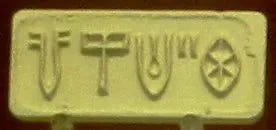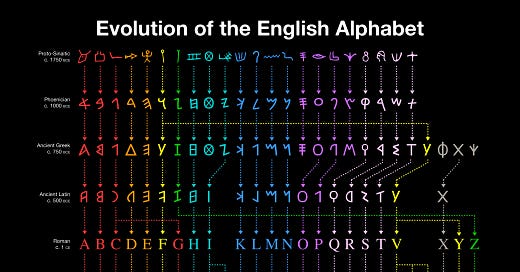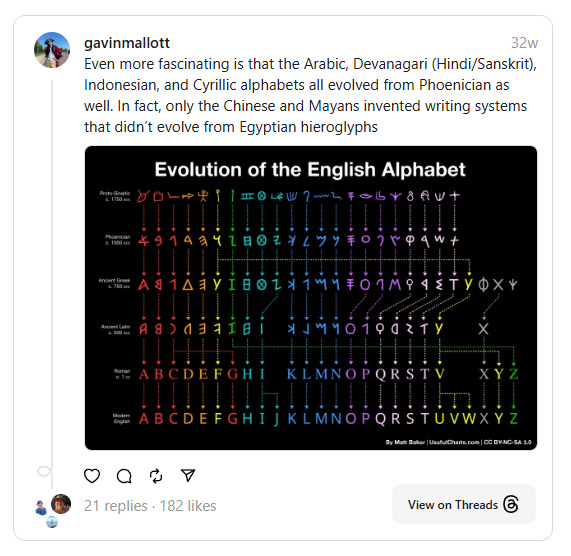Where do writing systems come from?
Writing was invented three different times in world history—in Mesopotamia, China, and Mesoamerica. But not all writing systems derive from those three original scripts. How can this be?
Sometimes you’ll see it said that all the world’s writing systems descend from three original scripts—Egyptian hieroglyphs, Chinese logograms, or Mayan hieroglyphs:
It’s true that most of the world’s writing systems derive from one of these three scripts. For example, the Latin alphabet, the Arabic abjad, the Hebrew alphabet, the Devanagari abugida (used for most languages in India), the other Brahmic scripts (including those in the Pacific), and the Greek and Cyrillic alphabets did all derive from the Phoenician alphabet, which itself derives from Egyptian hieroglyphs.
Prefer a video version of this post? Watch here:
Writing is a technology
Writing is a technology, and people can borrow the idea for a technology without borrowing the thing itself.
But what about Sumerian cuneiform? It predates the use of Egyptian hieroglyphs (c. 3400 BCE vs. 3250 BCE), with a continuous archaeological record showing the evolution from pictographic proto-writing to abstract signs.

Egyptian hieroglyphs, on the other hand, appear fairly suddenly in the archaeological record. There were also robust trade routes between Egypt and Mesopotamia which could have brought the tradition of writing to Egypt. Did Egyptian hieroglyphs derive from Sumerian cuneiform then? Scholars don’t actually know, because the situation is complex:
For starters, Egyptian hieroglyphs feature flora and fauna that are local to Egypt, so those signs could not have been borrowed from the Sumerians:
Secondly, cuneiform was a logo-syllabic system (a mix of signs representing words and signs representing syllables), while hieroglyphs were an amalgamation of ideographic, logographic, syllabic, and alphabetic signs. Cuneiform signs also represent vowels whereas hieroglyphs do not. The two writing systems operated on completely different principles. Some hieroglyphs recently discovered at Abydos may also slightly predate Sumerian cuneiform, challenging the idea that hieroglyphs evolved from cuneiform.
So how do we explain the fact that both writing systems started around the same time but aren’t related? Simple: Writing is a technology, and people can borrow the idea for a technology without borrowing the thing itself. The most likely scenario is that the Egyptians borrowed the technology and idea of writing from the Sumerians without borrowing the actual cuneiform writing system itself. Egyptian hieroglyphs and Sumerian cuneiform are therefore most likely unrelated scripts.
Other times cultures borrowed the technology of writing
This is hardly the only time that cultures have borrowed the technology of writing rather than specific writing systems:
Anatolian hieroglyphs (c. 1400–700 BCE), for instance, are typologically similar to Egyptian hieroglyphs, but not derive from them. They have no provable connection to Egyptian hieroglyphs or the Hittite cuneiform.

And then there’s the infamous Linear A (1800–1450 BCE), which has yet to be deciphered, but which we know developed independently of both the Egyptian and Mesopotamian writing systems.


Over in India, the undeciphered Indus Valley script (a.k.a. Harappan) was a proto-writing system used between 3500–1900 BCE, again with no demonstrable connection to Sumerian or Egyptian. All of the attestations of this script are quite short (the longest is 34 characters), calling into question whether it was writing or something more akin to merchants’ marks or accounting tokens. But notice how its start date for use closely coincides with that of cuneiform and hieroglyphs. Cuneiform likewise began as a system of accounting, making it possible again that the concept of writing was borrowed but not the actual script.


One writing system we know the origin of with certainty is Hangul, the script used to write Korean. While this script is clearly influenced by Chinese writing in its style, it is otherwise a completely independent creation, invented from scratch in 1443 CE by King Sejong the Great. So Hangul cannot be said to derive from Chinese writing.
As for Mesoamerica, Mayan hieroglyphs weren't actually the oldest script. The Olmec, Zapotec, and Isthmian writing systems all predate it. The Olmec inscription below known as the Cascajal block dates to 900 BCE, whereas the oldest Mayan inscriptions date to about 300–200 BCE. Interestingly, the characters on the Cascajal block aren't similar to or connected with later writing systems at all. This may have also been a case of borrowing the idea of writing.

While we're talking about borrowing the technology of writing, I would be remiss not to mention the Cherokee syllabary. While the influence from the Latin alphabet is obvious, its creator Sequoyah was illiterate when he began working on it, so the letters in this script don't correspond to their Latinate sound values. ⟨Ꭱ⟩, for example, represents the /e/ sound. This is also why the script is a syllabary (each character representing a syllable) rather than an alphabet (each character representing a sound). Sequoyah wasn’t aware that the English writing system operated on alphabetic principles.

The Cherokee syllabary in turn inspired the syllabic system used by many Canadian Inuit and Algonquian peoples. But while the inspiration came from Cherokee, the script itself is totally distinct.


Finally, even though this last case is uncertain, it’s not untoward to mention the undeciphered Rongorongo script of Easter Island. The script is native in origin, and may be a type of writing or proto-writing. If it’s true that the script predates European colonization (which seems likely given the little dating that’s been done of the tablets), then this would constitute a genuine 4th invention of writing in the world. If it developed after colonization, it would still present a case where the idea of writing was borrowed but not a specific script.


Conclusion
So, is it true to say that "only the Chinese and Mayans invented writing systems that didn’t evolve from Egyptian hieroglyphs". Not quite! There are plenty of individual writing systems which didn’t evolve from the Egyptian, Chinese, or Mayan scripts.
But it does seem to be true that writing as a technology has only ever been invented 3 times—in Mesoamerica, in Mesopotamia, and in China.
📖 Recommended Reading
I have an entire list of book recommendations about writing and writing systems!
📑 Bibliography
The Amazon and links in this post are affiliate links, which means that I earn a small commission from Amazon for purchases made through them (at no extra cost to you).
If you’d like to support Linguistic Discovery, purchasing through these links is a great way to do so! I greatly appreciate your support!





